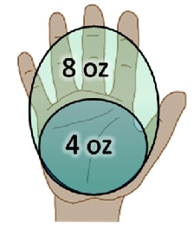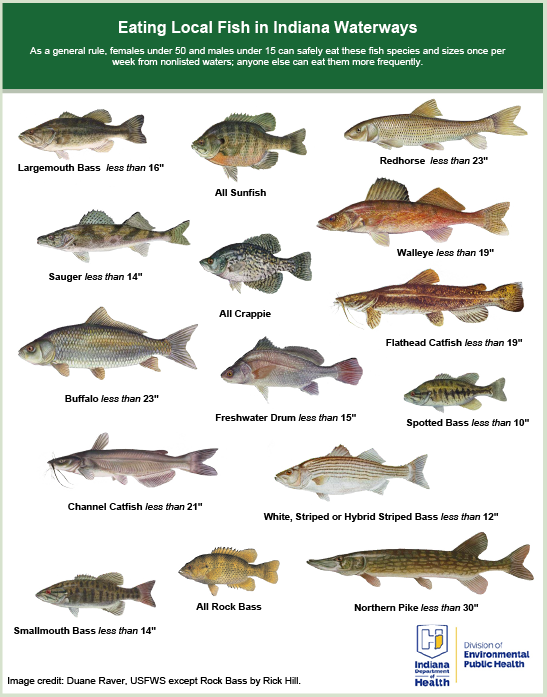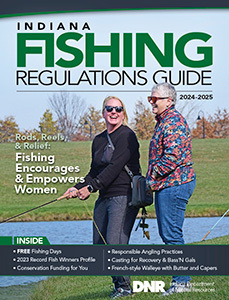Fish Consumption
Is it Safe to Eat Caught Fish?
Eating recreationally caught fish from Indiana waters can be a healthy, tasty part of your diet when you have the proper guidance. Because fish is lean in protein and low in saturated fat, it is a major source of omega-3 fatty acids, vitamin D, selenium, and other vitamins and minerals. Consuming fish maintains heart health, aids in healthy brain function, promotes bone health, and supports fetal development. While fish is a part of a healthy diet, it should be consumed in moderation, as some fish may contain chemicals which could lead to negative health outcomes.
Indiana has developed recommendations for the consumption of recreationally caught fish to help individuals make informed, healthy decisions about eating the fish that they catch. To ensure safe eating for both wild-caught and commercial fish, consult the full Indiana fish consumption guidelines at on.IN.gov/FishConsumption.
Health Considerations
The Indiana fish consumption guidelines are driven by two primary contaminants: mercury and PCBs. Perfluorooctane sulfonate (PFOS), which is a chemical in the per- and polyfluoroalkyl (PFAS) family, and pesticides are also considered when issuing guidelines.
These contaminants persist in the environment at low levels. While these low levels of contaminants do not pose a health risk in humans from direct contact with water bodies, they can accumulate in fish tissue over time. Similarly, the contaminants can accumulate in human tissue through the consumption of fish, potentially building to levels that pose a health risk.
Who is Most at Risk?
Anyone can be affected by chemicals found in certain fish; however, those most at risk for harmful health effects include individuals who are/could become pregnant or breastfeeding, and children under the age of 15.
What Should I Catch?
Some fish may contain higher levels of chemicals than others. Panfish and younger, smaller fish are generally less contaminated than larger fish of the same species. Indiana’s fish consumption guidelines are rated on a scale of 1 to 5, with 1 being “unrestricted consumption” and 5 being “do not eat.”
Where Should I Fish?
Eating fish from lakes and reservoirs is generally less of a concern than eating fish from rivers and streams. You can protect yourself by following recommendations provided in the fish consumption guidelines and fishing in waterbodies that have been tested for environmental contaminants. If a waterbody you are fishing does not have an advisory, or the advisory does not include information on the fish species you plan to eat, follow the Indiana Statewide Safe Eating Guidelines.
How Do I Prepare My Fish?
Fish should be cooked until they are flaky, opaque, and 145°F. To cut your fish, cut away the fat along the back, the fatty area along the side, and the belly fat.
How Much Fish Should I Eat?

A fish meal serving size is about 6 ounces of cooked wild-caught or commercial fish for a 150-pound person. To adjust meal serving size for a heavier or lighter weight person, add or subtract 1 ounce of fish for every 20 pounds of body weight.

Fish Consumption Guidelines Interactive Map
The Indiana Fish Consumption Guidelines are available as a mobile friendly, interactive map at on.IN.gov/FishConsumption. Users can search by address, body of water, or county to find guidelines.
Wild Fish Consumption Guidelines Groups |
|
Group |
Meal Frequency Categories |
1 |
Unrestricted consumption |
2 |
1 meal per week |
3 |
1 meal per month |
4 |
1 meal every 2 months |
5 |
Do not eat |
State Waters Carrying |
|
Water |
County |
Elliot Ditch |
Tippecanoe |
Government Ditch/Little Deer Creek |
Cass |
Grand Calumet River/Indiana Harbor Canal |
Lake |
Kokomo Creek |
Howard/Tipton |
Little Sugar Creek/Walnut Fork |
Montgomery |
Salt Creek |
Lawrence/Monroe to Monroe Lake Dam |
Marquette Lagoon (West Basin) |
Lake |
Wea Creek |
Tippecanoe |
Wildcat Creek |
Howard/Carroll: Downstream from the Waterworks Dam in Kokomo to the Tippecanoe County line |
Major Lakes & Rivers with Group 4 & 5 Species Guidelines* |
||||
Water |
County |
Species |
Size (inches) |
Group |
Clear Lake |
LaPorte |
Common Carp |
All |
5 |
Largemouth Bass |
All |
4 |
||
East Fork White River |
Daviess/Dubois/Lawrence/Martin |
Largemouth Bass |
All |
4 |
Lake James Chain (James, Snow, Jimmerson, Big & Little Otter) |
Steuben |
Northern Pike |
All |
5** |
Mississinewa River |
Randolph |
Channel Catfish |
All |
5 |
Common Carp |
30+ |
4 |
||
Delaware/Grant/Miami/Wabash |
Flathead Catfish |
29+ |
4 |
|
Muscatatuck River |
Jackson/Washington |
Channel Catfish |
18+ |
4 |
St. Joseph River |
St. Joseph (Baugo Bay Area to the Twin Branch Dam) |
Channel Catfish |
20+ |
4 |
St. Joseph (Twin Branch Dam to IN/MI State Line) |
Channel Catfish |
All |
5 |
|
Common Carp |
All |
5 |
||
Redhorse Species |
All |
4 |
||
Sugar Creek |
Parke County to Wabash River |
Flathead Catfish |
All |
4 |
Wabash River |
Fountain/Parke/Tippecanoe/Vermillion/Warren |
Carpsucker |
All |
4 |
West Fork White River |
Delaware/Hamilton (to Stony Creek)/Madison |
Channel Catfish |
All |
5 |
Marion (downstream of Broad Ripple Dam)/Morgan |
Flathead Catfish |
23+ |
4 |
|
Lake Michigan Fish Consumption Guidelines |
|
Species |
Meal Frequency |
Bloater Chubs |
One meal per month |
Brown Trout |
One meal per month |
Chinook Salmon |
One meal per month |
Coho Salmon* |
One meal per month |
Lake Trout* |
Up to 23" One meal per week |
23–29" One meal per month |
|
29"+ Do Not Eat |
|
Lake Whitefish |
One meal per week |
Rainbow Smelt |
One meal per week |
Rainbow Trout |
One meal per week |
Yellow Perch |
One meal per week |
Ohio River Fish Consumption Guidelines |
|
Species |
Meal Frequency |
Largemouth Bass* Smallmouth Bass* Spotted Bass* |
One meal per month |
Blue Catfish |
One meal per week |
Channel Catfish* |
Up to 18" |
18"+ Six meals per year |
|
Common Carp* |
One meal per week |
Crappie Species |
One meal per week |
Flathead Catfish |
One meal per month |
Freshwater Drum |
One meal per month |
Hybrid Striped Bass |
Six meals per year |
Sauger |
One meal per week |
Striped Bass* |
One meal per month |
Sucker Species |
One meal per month |
Walleye/Saugeye* |
One meal per month |
White Bass |
One meal per month |

